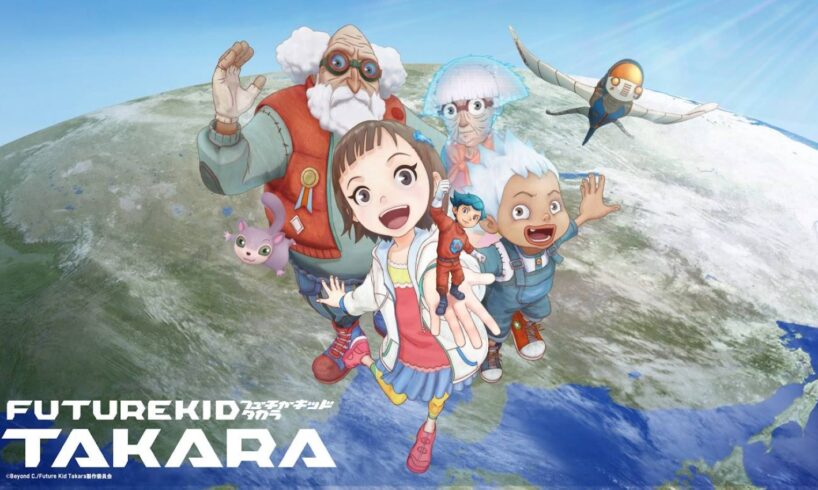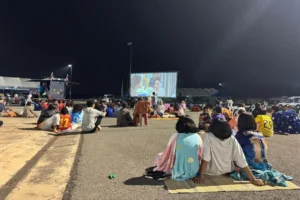
Osaka –
The first episode of “Future Kid Takara,” a new series of anime shorts, opens with the thrilling scene of a boy named Takara and a scientist named Dr. Amory running away from a tornado in 2100.
“Doctor, it’s hail!” the boy shouts as he tries to dodge hailstones and bolts of lightning. “I know!” the scientist shouts back. As they are swept up by the tornado, Takara hits a time travel button attached to Dr. Amory’s body, taking them to the year 2024, when the climate crisis is not nearly as severe as it would become.
In 2024, they meet 12-year-old Sara, and together they travel around the world to discover the “beautiful Earth” that no longer exists in the future. On the journey, they see firsthand that signs of climate change are already emerging: the melting glaciers of Greenland, a starving polar bear, droughts and wildfires that rage in one part of the world and floods and downpours that intensify in another.
The 11-episode series, produced by NHK Enterprises and to be aired on NHK Educational TV in November, attempts to educate the young about climate change and its devastating impacts, as well as its root cause, namely our addiction to fossil fuels.
The goal of the series is not to simply present a dystopian future, however. Instead, it aims to inspire hope for positive changes among elementary school students, the series’ main target audience, according to Seita Emori, a climate scientist at the University of Tokyo who provided scientific supervision for the series.
“The series has educational, classroom use in mind,” he says, noting that since the Sustainable Development Goals were incorporated as part of the school curriculum for elementary schools in 2020, it has become standard for schools to teach students about climate change. “So the thinking is that children are more willing to take in the message naturally.”
Emori was one of the speakers at an event last month at the Osaka Expo, where the series was screened for the first time.
“Global warming is a very big issue and it is hard to teach in schools,” he told an audience of 1,900 people.
“The crisis of humanity, civilizations and the Earth … they may all sound scary,” Emori continued. “But first, we want people to understand that this is indeed a huge issue. And secondly, we want to change the mindset that it cannot be helped, that there’s nothing we can do. This is a story about how we can change our future together, because that’s most important when it comes to tackling global warming.”
The anime is all the more important given the unique challenge that climate educators face in Japan.
Voice actors from “Future Kid Takara,” as well as soccer player Shinji Ono (far right), appear at a screening of the series at the Osaka Expo.
| Tomoko Otake
According to the 2025 Human and Climate Change Report by global market research firm Ipsos, just 40% of Japanese respondents said they feel individual action is necessary to address climate change, down 19% from 2021. This puts Japan at the bottom of the 32 countries surveyed.
Perhaps more alarmingly, in Japan, climate indifference is most widespread among younger generations. A 2023 Cabinet Office survey polling 3,000 people over the age of 18 showed that just 31% of 18- to 29-year-olds and 30.3% of those in their 30s replied they were interested in climate issues. Interest rises with age, with 60.4% of respondents over 70 saying they are interested.
Yosuke Buchmeier, assistant professor at the University of Oxford’s Nissan Institute of Japanese Studies, attributes this to two main factors.
Schools often discourage people from political activism or even from political discussions, he said. Also, Japan’s media coverage, which often treats extreme weather as one-off news events despite growing evidence attributing them to climate change, hasn’t helped.
“The topic of climate change is very large in the media in the U.S. or Europe,” Buchmeier says. “In Japan, there is a lot of reporting about extreme weather, like typhoons, flooding and strong rain, but this is very rarely linked to climate change. … Due to this way of media coverage, people in general have a comparatively low awareness of the issue.”
Kyoko Gendatsu, an NHK journalist and a producer of the anime series, also said during a recent lecture for novelists and essayists that the nation’s climate apathy is part of a bigger problem in which educators stress conformity to petty rules and precedents and discourage students from speaking their own minds.
She cited a 2024 survey by the Nippon Foundation think tank of 17- to 19-year-olds across six countries, which found that just 45.8% of those polled in Japan said they think they can change the country or society with their actions — lower than respondents in the U.K. (56.1%), South Korea (60.8%), the U.S. (65.6%), India (80.6%) and China (83.7%).
“There are many children in Japan who have not had success speaking out on things (and making positive changes),” she said during the lecture. “We must nurture a generation of young people who believe they can change the future with their own efforts.”
Enter “Future Kid Takara.”
The screening at the expo also featured talks by a cast of popular voice actors and former Samurai Blue midfielder Shinji Ono, who appeared in the series as a real-world character along with two other top players and sounded the alarm about the prospect of climate change-driven extreme heat making it impossible to stage matches in the future.
Emori says the series — which producers hope to screen at the upcoming COP30 in Brazil with English subtitles — sets itself apart from other Japanese anime that have incorporated the theme of climate change but have avoided pushing the issue to the forefront, such as “Weathering With You,” a 2019 blockbuster by Makoto Shinkai.
While full of allusions to the climate crisis, “Weathering With You” fails to confront the causes and solutions for the incessant rain in Tokyo, treating it as a mere backdrop for a teen romance in which a boy who flees to Tokyo from the countryside is drawn to a girl blessed with an ability to control the weather. A Wired writer commented in a 2020 article that some lines in the movie even “sound like outright climate denialism.”
“That’s an entertainment film, but it does include elements of climate change,” Emori says about the movie. “However, once people start to think of a film as a climate change story, the audience that just wants to enjoy it as entertainment tends to pull back. They might feel it’s become ideological or preachy, and if that happens, the work fails as entertainment. I think that’s been the prevailing mindset in Japan up until now — and probably true in practice, too.”
The 2021 film “Don’t Look Up,” by contrast, an American black comedy about two astronomers desperately warning of an approaching comet and the impending destruction of humanity, comes to mind as a scathing satire of public apathy toward the climate crisis.
That leads to a pair of key questions for directors and producers.
Should creators depicting climate change in their works, be it anime, live-action films or art, bear in mind their works might affect the audience’s climate attitudes? Should they care at all about their works’ climate messaging?
At a workshop in 2023, a group of children were asked to draw how they imagine Japan’s climate would be in 50 years.
| COURTESY OF KELVIN TANG
Kelvin Tang, a postdoctoral climate education researcher at the University of Tokyo, says that’s a “super dilemmatic” issue.
“As a climate change education researcher, I really want to advocate to these creators that their … works are super influential in shaping how people feel, think and act toward one topic (like) climate change,” he says.
While understanding that many creators don’t want to be seen as preachy, Tang says he wants to advocate to everyone involved in films and other art forms to “participate in mainstreaming these issues.”
Having seen the trailer for the “Future Kid Takara” series, he sees it as “super relevant” for learners who are not yet aware of the climate crisis.
“It’s a very good first step for climate change education, especially for students,” he says.
Tang himself has explored art-based learning in relation to climate change. At one workshop he organized in Kashiwa, Chiba Prefecture, in 2023, he gathered a group of about 10 children from ages 7 to 11 from the community, introducing to them the idea of climate change with simple, easy-to-understand cartoons, pictures and videos.
Next, he conducted a simple quiz on possible actions that can be taken, asking them to choose between a picture depicting drying clothes with a dryer and one showing clothes hung outdoors.
Then, he asked the children to imagine Japan’s climate 50 years from now, and make a drawing based on their imagination.
Some students drew a burning forest or even a burning Earth, while others drew pretty flower beds or a grassy field.
“I see this as a hope, because some students, after learning about climate change, about this alarming situation, still have that hopeful future (in their minds),” he said.
At the end of the session, Tang had the students discuss what actions they can take to help with the situation. Ideas raised ranged from turning off lights to reducing meat consumption.
The key is to find how to really harvest this hope, he says, “for them to be an agent of change, to change these concerns into constructive action.”





